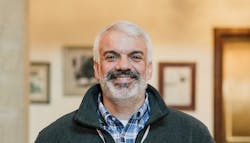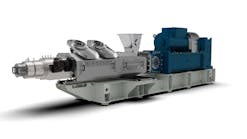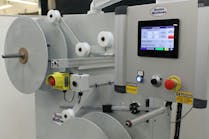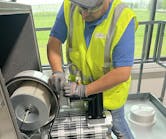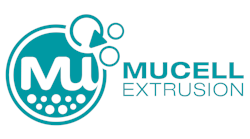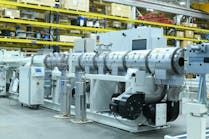By Karen Hanna
ID Additives founder Nick Sotos’ business philosophy sounds like a perfect antidote for these anxious times:
Reverse paranoia.
“If you help enough people, you will feel like they’ll help you. So, you’ll feel like people are conspiring to do good for you,” Sotos said.
At 55, Sotos is himself conspiring to do good, as he cuts down on his workload at the two businesses he started. In coming years, he hopes to visit the Major League Baseball stadiums he’s so far missed — and find ways to extend his philanthropic reach beyond St. Baldrick’s Foundation, a children’s cancer research charity he supports. In the meantime, when he’s not working the phones buying and selling regrind for Carver Plastics, or helping iD Additives’ customers manage skyrocketing resin prices, you’re likely to catch him at a Chicago White Sox game, his occasionally bald head bowed over an e-book.
He recently spoke with Plastics Machinery & Manufacturing senior staff reporter Karen Hanna.
How did you get your start in plastics?
Sotos: My dad was a butcher for 30 years, and I grew up in that world, selling to hotels, country clubs, fine dining, and I wanted to get a change and got into plastics.
My wife was the safety manager at a thermoformer here in Chicago. My father-in-law was president of a company called Clear Pack. He said, “There’s a broker that’s looking for a salesman out here in the Midwest. I can get you an interview, if you want.” I started with I. Stern and Co. Inc. in the late '90s. They’re a resin broker on the East Coast. We specialized in polystyrene and polypropylene. I learned a ton about the business.
In 2004, I left, and I started Carver Plastics. I buy and sell some regrind; I do some commission sales. We buy black, color, different things like that, that we just bring in. We buy and resell.
After I’d started Carver, a customer came to me and said, “Look, I’ve got a line of foaming agents. Would you be interested in selling these?” I had never done anything with additives. So, I created iD additives.
The first employee I hired was Ron Bishop. He’s my technical manager for the foaming agents. That's kind of how I built my business; every line that I have, I have a technical manager. Dave Denzel is our technical manager for all our purge compounds. Bryan Whitaker is our technical manager for all our MRO products.
How important is having the right people?
Sotos: When I left I. Stern, I was by myself, but I always knew that I was going to have a team. I feel pretty strongly about having family here. And it’s worked out really well for me. We have a combination of family and people that we’ve brought in from the outside, and we all work together. My daughter Carolyn does a lot of our sales and marketing. My brother’s our operations manager. I’m starting to look at where the next generation is going to be and how we keep the business going forward. I’m looking at where our company is going to be five years from now, 10 years from now. I always think I’m always going to be here. But am I going to be here working as much as I work right now? I don’t think so.
What do you see as iD Additives’ role in helping customers?
Sotos: My father-in-law always told me, “As big as this industry is, it’s tiny. Everybody knows everybody, so you always want to do what you say you’re going to do.” My philosophy is, if I say I’m going to do this, I get it done.
I don’t overpromise and undersell.
The most important thing is I can make phone calls all day. But really helping the customer understand our product and how to use it, that’s what creates value. That’s what separates us from people going, “Hey, here’s a sample of a product, let me know how it runs.” Instead, we say, “Here’s a sample of our product. Let us show you how to maximize what it does.” And that’s worked really well for us.
Over the years, our technical guys have learned a lot of new ways to maximize what we do. We come in and say, “We’re a different set of eyes looking at it.”
Ron has been doing this for so many years, he’s seen so many different things, that he just keeps adding to his knowledge base.
A lot of times, Ron will go, “Here’s what I want to do. I want to adjust the temperatures, I want to adjust this . ...” And the processor will say, “Well, you can’t do that.” Well, why? “Well, this is how we’ve always done it.” Through going and seeing all these different problems, and working on solving them, you add to your knowledge base, and you become better at what you do. But if you’re staying in the same place, you’re looking at same problem, day in, day out, it’s tougher.
What does the volatility in the resin market mean for iD Additives?
Sotos: Ron, when he first started with me, always said, “If you want to cut costs, either foam it or fill it.”
When resin’s like this, I get a lot of phone calls. I couldn’t be busier. A lot of guys that we’ve talked to in the past who were not interested, they’re calling now and saying, “Hey, let’s take a look at this.” That’s opened a lot of doors for us, whether it’s foaming or filling.
We were able to save people money on parts when resin was 50 and 60 cents a pound, and it’s at $1.20 right now. Even when resin was super-cheap, we were still able to save cycle time and energy cost.
A customer calls us up a lot of times and they say, “Look, here’s the part,” and they’ll send us a picture of it. And Ron will go out there and he’ll show them how to run the foaming agent. And once their process engineers know Ron’s process, they’ll call back and place an order. I’ll be like, “OK, so that part worked out?” What they say back is, “Oh, we didn’t use it on that part. We threw it into something else.” So, they started trying it in other parts in the plant, and they found that it worked better in something else. Once you know how to use it, you can translate it to other parts in other applications.
There are items that are $2 a pound. You don’t have to take out a lot of weight to save money on something that costs $2 a pound. If you take out 5 percent of the weight, you’re taking out a dime.
When resin prices are crazy like this, the purge business gets a bump, too. When resin is 50 cents a pound, you might have somebody say, “Hey, I just run through resin and, whatever comes out, we throw into black.” But when resin is $1.50 a pound, you want to try to purge as quickly as you can. All of a sudden, you hear, “Our boss told us we’ve got to limit how much resin goes through. We can’t scrap too much.”
What’s your niche at iD Additives and Carver Plastics?
Sotos: I love sales. I love figuring out what somebody is looking for and how I can help them. The way I've done things, the way I look at business, my job in life is to get my technical guys in front of people. I take a very low-key approach in my sales. Plastics is a multi-billion-dollar business. If we can do something for you, great. If we can't, I'm not going to hound you; there's tons of other calls to be made. A lot of times we’ve gotten business from people calling us from recommendations from some of our other customers. You know, they’ll call us and say, “Hey, you’re working with so and so. Can you come in and see us?” So, I think we've done a good job of taking care of our customers doing what we say we're going to do.
I still love sales and business. When I’m out at various country clubs, in hotels, I’ll talk to people about meat costs: “Where are you buying these steaks from? What’s your plate cost?”
If I were to ever retire, if I want to keep a toe in the business, I’d always have Carver Plastics, if I wanted to stay in and just make calls and buy and sell.
What are the biggest challenges and opportunities for the plastics industry?
Sotos: I’m a huge fan of the plastics industry. We’re obviously an essential business. When my daughters were in high school, I sponsored the Society of Plastics Engineers’ PlastiVan to go into their science classes every year for two or three days and talk to them about polymers, the plastics industry and careers in plastics. So, I’m trying to do my thing to promote the plastics industry. That’s a great way to do it is when you start teaching people, or kids, at a younger age, middle school, about the benefits of plastic and the need to recycle and let them know that these things are recyclable. They need to understand why it’s good. And how you work to make it so that it’s not perceived as bad, and that it doesn’t end up being a bad byproduct for the environment.
But there’s pros and cons to everything. I saw something a couple weeks ago that said, “It’s not a plastics problem. It’s a people problem.” To me, that’s not the right answer. If it’s a people problem, it’s a plastics problem. Every time you see a bag in a tree, we lose. That’s a tough image to fight. You have to find a way to make it so that people want to recycle, so that bag doesn’t end up in that tree. You have to find a way to incentivize. Plastics is a great thing; we couldn’t function without it. But we need to be able to work with all the stakeholders, the consumers, the stores, the restaurants ... everybody’s got to come together to find a way to minimize this scrap.
How did you get started with St. Baldrick’s?
Sotos: My daughters at that time were 10 and 8. We’re watching the news, and a thing comes on about St. Baldrick’s, shaving their heads for children’s cancer research. And I just kind of tossed it out as a joke: “I should do that.” I laughed, and I walked out of the room. Well, my daughter, Carolyn, went to school the next day and told everybody “My dad’s doing the thing where he shaves his head.” One of our neighbors, one of her classmate’s dads, showed up at our house. And he’s like, “Hey, I wanted to tell you I think what you’re doing is awesome. I want you to know that our son, Charley, is a cancer survivor. So, let me know when you’re set up. I want to donate.” And I was like, “Uhh … sure.” He left, I closed the door, and my wife looked at me and said, “What was that all about?” I said, “I guess I’m shaving my head.” After he said all that, I couldn’t say, “I'm not going to do it.” So, we set up the website. I told my customers; all my customers wanted to donate. We raised a decent amount of money. Next year, one of my biggest customers calls and says, “Hey, it’s that time of year, where do we send the check?” And I said, “Oh, my God.” And I’ve probably raised over the years over $100,000, I believe.
It’s been something that a lot of people know me for.
Every time St. Baldrick’s has had events, I’ll go to one and they have the people who shave your head. And you get to meet the families. It’s something else to see when people are faced with some of the adversity that they’re faced with and still to maintain a positive attitude, I think is remarkable.
That first year in 2005, I shaved my head, and it was in March, the White Sox started their season. And they got off to a white-hot start. They’re playing great baseball, and then in September, they started losing. I actually went back in September and shaved my head again. And the White Sox ended up winning the World Series that year. So, I feel like I did my part for them.
Besides work, how do you spend your time?
Sotos: I have season tickets for the White Sox and, and if nobody can go, I’ll bring my Kindle when I go to the game, and I’ll read my Kindle and watch the game. It just kind of moves along, nice and easy.
I read business, business histories, or business biographies. You can learn from them. Whereas I saw a book the other day that was like, “Learn how to negotiate like your life depends on it.” I was like, “That’s no way to negotiate.”
I remember there was one saying in a book — “reverse paranoia” is what it was called. I say that we help people, even if our product doesn’t work. If I know somebody else’s that does, I'll be like, “Hey, you should call this guy.” And I help the customer. If it works out, he calls me back and he’s like, “Hey, you didn't have to do that.” Hey, I don’t have to get every penny. I feel like if we help enough people get the stuff they’re looking for, we’ll never have a problem getting the stuff we’re looking for.
How would you like to be remembered?
Sotos: Going forward, some of the issues that are there in the plastics industry, and what is our legacy going to be? Those are some of the things that I’ve started looking at.
This industry and this business have been really good to me. It’s allowed me to see the country, it’s allowed me to do a lot of things, go to a lot of places, do things that I wouldn’t have otherwise been able to do.
We’re not as big as some of the other companies out there, but do you look at maybe trying to set up —I don’t know if the word is foundation — but something that creates scholarships for kids that want to go into the plastics industry, or money to help the oceans. … I don’t know what that's going to be, but we should be looking at these things. We’ve had a lot of success, and it’s created a lot of opportunities for me and for my family. And I always feel like at some point, you have to look for a way to give that back, give back something.
Karen Hanna, senior staff reporter
Just the facts
WHO IS HE: Nick Sotos
AGE: 55
TITLE: President and founder of regrind broker Carver Plastic Products (2004), named after his now-grown daughters, Carolyn and Veronica; and iD Additives Inc. (2005), named in reference to “innovative developments,” which sells additives, including fillers and foaming agents, as well as MRO products.
BUSINESS LOCATION: La Grange, Ill.
EMPLOYEES: 13
Karen Hanna | Senior Staff Reporter
Senior Staff Reporter Karen Hanna covers injection molding, molds and tooling, processors, workforce and other topics, and writes features including In Other Words and Problem Solved for Plastics Machinery & Manufacturing, Plastics Recycling and The Journal of Blow Molding. She has more than 15 years of experience in daily and magazine journalism.
Request More Information
MAS 110 increases throughput
Censco acquiring MuCell Extrusion Technology
KraussMaffei now building extruders in U.S.

